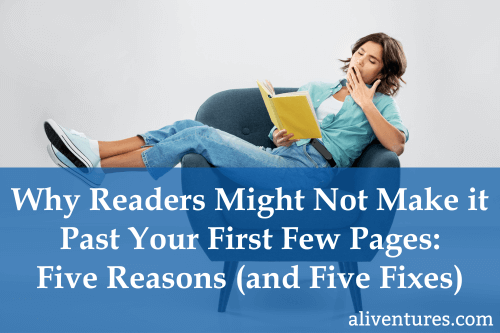Why Readers Might Not Make it Past Your First Few Pages: Five Reasons (and Five Fixes)

Have you ever started reading a novel and given up within the first few pages?
Unless you’re a particularly tenacious (or stubborn!) reader, you probably have. It’s often clear early on that a book simply isn’t working for you.
While I’ve sometimes pushed on with books that I wasn’t initially completely convinced by and then enjoyed them, my reading time is limited and I’ll often give up on a book if it’s not grabbing me in the first few pages.
If you’re worried that readers may give up on your novel, here are five reasons why they might do so … and how you can turn things around in your next draft.
Reason #1: Your Writing Doesn’t Make You Seem Like a “Safe Pair of Hands”
As a reader, I’m always hoping to encounter writers who can competently tell a story that draws me in. I’m not expecting literary greatness – but if the writing feels awkward or clumsy, then I probably won’t read on.
This may be partly because it’s hard to take off my writing/self-editing hat, and I’m always slightly on the lookout for signs of bad writing … but I think even non-writers have a good sense of when a writer has full control versus when a writer’s work needs more editing.
Fix It
If you feel that your writing itself is letting you down a little, here’s the good news: this isn’t as hard to fix as you might imagine. We all improve our craft over time, and you can speed up this process a lot.
One of the best things you can do is to get direct, specific feedback from reasonably experienced writers (perhaps in a writers’ group) or an editor on your first chapter. They should be able to point out areas where your writing is falling a little flat or your sentences need extra work.
It’s also worth remembering that the opening scene of a novel is likely to need a lot of rewriting – you have a lot to juggle as you introduce your world and characters, and you’ll need to take a few passes to get it just right.
Reason #2: Your Characters Are Unengaging
Another reason why readers may not make it very far is because your characters just aren’t interesting to them. They don’t feel like real, engaging people with problems that the reader can easily care about.
Unengaging characters might be:
- Too passive. They’re sitting back and letting life happen to them – rather than doing anything to fight for what they want and need. While characters may be stuck in reactive mode in the first half of a novel, you don’t want characters who just sit around doing nothing.
- Too tedious. Mr Collins in Pride and Prejudice is a great secondary character, but he definitely wouldn’t make for a good protagonist or viewpoint character. If your main character is a ponderous or meticulous sort of person, make sure you’re showing that in an interesting way – not boring the reader.
- Too one-dimensional. Maybe your character feels like a caricature or stereotype. We want characters who feel like real people, not cardboard cutouts. Even in plot-driven genres where the protagonist may have a fairly flat arc (thrillers and horror novels, for instance), you want to have characters who feel well-rounded.
Fix It
No character is irredeemably boring … but you may need to shake things up a little.
If your main character spends the first five chapters whining in their bedroom, put in plot events that force them to react and do something. If your protagonist is an extraordinarily meticulous detective, show their results, not the entire process. If you have one-dimensional characters that rely on stereotypes, give them hidden depths – perhaps through something in their backstory.
Reason #3: There’s Too Much Description
It might have been possible to start a novel with page after page of description in the 19th century. But today, novels that open with lots of description are likely to lose the reader early on. You could give us a beautiful, lavish picture of a formidable country house … but we’re unlikely to read paragraph after paragraph about the house when what we’d like to know is who lives there.
Description can be an issue even when you’re introducing us to characters. Sure, we probably want enough description to picture your characters, but we don’t need you to detail them from head to toe.
I’ll admit to a bit of a bias against description (I find it the hardest thing to write) – but I definitely think a “less is more” approach is best in the opening chapters of a novel.
Fix It
Readers want to get straight into the story. Sure, you’ll need to give us a picture of the setting, but not at the expense of introducing us to the characters and getting the action started.
If your beta readers (or you!) feel that your story gets off to an overly slow start, go through the first chapter and highlight descriptive passages of text. Could you cut these down and focus on a few key, telling details?
You might also be able to weave your description in with dialogue or action, giving readers the details they need while moving the story along. If you’re writing in the first-person or third-person limited (these are by far the most popular options for modern novels), then you can also describe things through your character’s eyes. One character’s “tacky” is another’s “ornate” – so the words you use in your descriptions can help give us a better picture of your character’s personality.
Reason #4: There’s Too Much Happening
Sometimes, the problem isn’t that you’re getting off to a slow and descriptive start – instead, you’ve thrown the reader into a whirlwind of action a bit too fast. Opening with something dramatic can work really well, but if you’re introducing six different characters and having lots of things happening at once, it’s probably a bit too much.
From the reader’s perspective, when we don’t yet know and care about the characters, and we’re settling into a story, loads of fast-paced action can make it easier to simply close the book and read something less frantic instead.
Fix It
As readers, we normally expect to have one key character (the protagonist) to root for. Make it clear, as quickly as possible, who this story is going to be about. Follow the action that’s all about them. If there are other things happening, keep those distant and in the background – your protagonist (and the reader) can be told about these events later.
You’ll probably also need to slow down the pace of your first chapter, giving the reader a chance to get into the story without feeling overwhelmed.
Reason #5: The Reader Has No Idea What’s Going On
Sometimes, you might be clear in your head about exactly what’s happening in the first few pages of your book – but your reader isn’t getting it at all.
In some cases, it makes sense to open a story with the main character confused or disoriented. I still remember reading Roger Zelazny’s Nine Princes of Amber in my early teens, and one of the things that drew me into that book was the opening, where Corwin wakes up in a hospital with amnesia, disorientated but quickly realising that he’s being drugged. We gradually get to learn more about the story world as he pieces his life together.
That opening worked because although the character was confused, the actual situation he was in was clear: he was awakening from a coma or heavily drugged state. Project Hail Mary uses a similar technique, and again, isn’t confusing – though of course both openings are intriguing and we want to keep reading to find out not only how the character got into this situation, but to discover (along with them) who they are.
Your novel’s first few pages become a problem when they’re bewildering to the reader. This may be related to the previous issue – that you simply have too much going on – but it may simply be that you haven’t explained things clearly enough.
Fix It
Personally, I don’t think readers should have to work hard to understand your story. Sure, you might have a driving question or mystery that’s slowly being revealed … but they shouldn’t be confused about what an individual paragraph or sentence actually means.
If your writing isn’t clear enough, rework it. Watch out for ambiguities or clumsily worded sentences – these are normal (perhaps inevitable!) in your first draft, but they need to be fixed before your story is read by a wide audience.
Drawing the reader into a story isn’t easy. When I’m deciding what to read next, there’s always a period of reluctance: I know I need to get into a whole new book, with characters I haven’t yet learnt to care about, and a plot that might be too thin or too complicated to be satisfying. I need an author who’ll bring me into their story-world without confusing me, boring me, or throwing too much at me on the first page!
I’d love to hear what makes you read on when you first pick up a book – or conversely, what you’ve discovered in your own writing that helps to make for a great first few pages. Do drop a comment below to share your thoughts.
About

I’m Ali Luke, and I live in Leeds in the UK with my husband and two children.
Aliventures is where I help you master the art, craft and business of writing.
Start Here
If you're new, welcome! These posts are good ones to start with:
Can You Call Yourself a “Writer” if You’re Not Currently Writing?
The Three Stages of Editing (and Nine Handy Do-it-Yourself Tips)
My Novels

My contemporary fantasy trilogy is available from Amazon. The books follow on from one another, so read Lycopolis first.
You can buy them all from Amazon, or read them FREE in Kindle Unlimited.


0 Comments